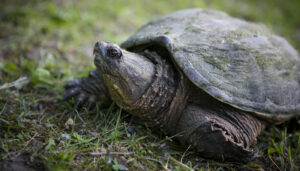Curled up beneath layers of earth or nestled in the safety of underwater hideaways, the enigmatic world of turtles holds a seasonal secret: ‘Do turtles hibernate?‘ This age-old question unlocks a realm of fascinating behaviors and survival strategies employed by these ancient creatures.
On this page, we will delve into the mysterious phenomenon of turtle hibernation, uncovering the hidden depths of their winter slumber and the remarkable adaptations that ensure their endurance through the coldest of seasons.
Do turtles hibernate?

Yes, many species of turtles undergo a state of dormancy, which is similar to hibernation, during the colder months of the year. This behavior is more commonly referred to as brumation in reptiles. During brumation, turtles become less active, their metabolic rate decreases, and they may not eat for an extended period.
The specifics of brumation can vary among different turtle species. Aquatic turtles may burrow into the mud at the bottom of ponds or slow-moving rivers, while terrestrial turtles may dig burrows in the ground. The purpose of brumation is to conserve energy when environmental conditions, such as temperature and food availability, are less favorable.
Also, not all turtles hibernate or brumate. Some species, especially those in warmer climates, may remain active throughout the year. Additionally, captive turtles may not experience brumation if they are kept in a controlled environment with a consistent temperature and food supply.
If you have a pet turtle, it’s essential to research the specific needs of its species to ensure proper care, including whether brumation is a natural part of its life cycle.
Understanding Turtle Hibernation Patterns
The hibernation or brumation patterns of turtles can vary depending on the species, geographic location, and environmental conditions. Here are some general aspects to understand about turtle hibernation:
- Species Variation:
- Different turtle species have different requirements for hibernation. For example, some aquatic turtles may hibernate underwater, while terrestrial turtles may burrow into the ground.
- Temperature Influence:
- Hibernation is often triggered by cooler temperatures. As temperatures drop, a turtle’s metabolism slows down, and they become less active. This is a way for them to conserve energy during periods when food may be scarce.
- Aquatic Turtles:
- Aquatic turtles may hibernate in the mud at the bottom of ponds or slow-moving rivers. They can absorb oxygen through their skin and cloaca during hibernation. It’s important for the water not to freeze completely, as some oxygen exchange needs to occur.
- Terrestrial Turtles:
- Terrestrial turtles, such as box turtles, may dig burrows in the ground to hibernate. The depth of the burrow helps them avoid extreme temperature fluctuations. They may choose locations with relatively stable temperatures to prevent freezing.
- Duration of Hibernation:
- The duration of hibernation can vary. Some turtles may hibernate for a few weeks, while others may remain dormant for several months. The length of hibernation depends on factors like species, local climate, and the turtle’s overall health.
- Preparation for Hibernation:
- Before entering hibernation, turtles may alter their behavior. They might reduce their food intake and find a suitable location for hibernation. This preparation is essential for ensuring they have enough energy reserves to sustain them through the dormant period.
- Captive Turtles:
- Pet turtles may exhibit natural hibernation behaviors if their environment mimics the conditions they would experience in the wild. However, some captive turtles may not go through hibernation if kept in a controlled and warm environment. It’s crucial to research the specific needs of your turtle species.
- Monitoring Health:
- It’s important to monitor the health of turtles during hibernation. Some species are more sensitive to temperature fluctuations, and improper conditions can lead to health issues. If you have a pet turtle, be aware of the specific hibernation requirements for its species and seek veterinary advice if needed.
Always consult species-specific care guidelines or a reptile veterinarian if you have concerns about the hibernation patterns or general well-being of your pet turtle. Understanding the natural behaviors of your turtle species is crucial for providing appropriate care.
Types of Turtles that Hibernate
Many species of turtles hibernate or undergo a state of dormancy during colder months. Here are some types of turtles that are known to hibernate:
- Box Turtles (Terrapene spp.): Box turtles are terrestrial turtles found in North America. They are known to hibernate in burrows during the winter months, digging into the ground to avoid extreme temperatures.
- Wood Turtles (Glyptemys insculpta): Wood turtles, native to North America, are semi-aquatic and may hibernate in winter. They often burrow into the streambanks or substrate to hibernate.
- Painted Turtles (Chrysemys picta): Painted turtles are common in North America and are often found in aquatic habitats. During the colder months, they may hibernate in the mud at the bottom of ponds or slow-moving rivers.
- Snapping Turtles (Chelydra serpentina): Snapping turtles, both common and alligator snapping turtles, are known to hibernate. They often bury themselves in the mud or substrate at the bottom of bodies of water during the winter.
- Mud Turtles (Kinosternidae family): Various mud turtle species, such as the Eastern mud turtle (Kinosternon subrubrum), are found in North America and may hibernate in mud or burrows.
- Softshell Turtles (Apalone spp.): Softshell turtles, like the spiny softshell turtle (Apalone spinifera), are known to hibernate. They often bury themselves in the substrate of rivers or ponds during the winter.
- European Pond Turtle (Emys orbicularis): This turtle species, native to Europe and parts of Asia, may hibernate during the winter months. They often seek refuge in mud at the bottom of ponds.
- Asian Box Turtles (Cuora spp.): Various species of Asian box turtles, such as the Chinese box turtle (Cuora flavomarginata), may hibernate in the wild. They are known to burrow into the substrate to escape extreme temperatures.
Keep in mind that the hibernation habits can vary among individual turtles, even within the same species. Additionally, the specific behaviors and requirements for hibernation can be influenced by the turtle’s geographic location, local climate, and environmental conditions.
So, if you have a pet turtle, it’s essential to understand the specific needs of its species to provide proper care, including any requirements for hibernation.
Factors influencing hibernation in turtles
How turtles prepare for hibernation?
Turtles exhibit specific behaviors to prepare for hibernation, also known as brumation in reptiles. The preparation for hibernation is crucial for their survival during periods of colder temperatures and reduced food availability.
Here are some common ways turtles prepare for hibernation:
- Reduced Activity:
- As the temperatures begin to drop, turtles typically reduce their activity levels. This reduction in movement helps conserve energy, as the turtle’s metabolism slows down in response to cooler conditions.
- Decreased Feeding:
- Turtles often decrease their food intake as winter approaches. This reduction in feeding is a natural response to the lower temperatures and the scarcity of food during the winter months.
- Locating Suitable Hibernation Sites:
- Turtles actively seek out suitable hibernation sites before the onset of winter. Aquatic turtles may move to deeper parts of ponds or slow-moving rivers, while terrestrial turtles may find suitable burrows or dig their own.
- Burrowing:
- Many turtles, especially terrestrial species like box turtles, are known to dig burrows in the ground as part of their hibernation preparation. These burrows provide insulation and protection from extreme temperatures.
- Environmental Cues:
- Turtles are often sensitive to environmental cues such as changes in temperature and day length. Shorter days and cooler temperatures signal to turtles that winter is approaching, prompting them to initiate their preparation for hibernation.
- Metabolic Changes:
- As turtles prepare for hibernation, their metabolic rate decreases. This reduction in metabolic activity helps them conserve energy during the dormant period when they are not actively foraging or moving.
- Seeking Stable Microenvironments:
- Turtles may actively seek out stable microenvironments within their habitat. For example, finding areas with consistent temperatures and protection from harsh weather conditions helps ensure a more successful hibernation.
- Hydration and Food Storage:
- Turtles may hydrate and store food reserves before entering hibernation. This helps them sustain themselves during the dormant period when they are not actively feeding.
- Behavioral Changes:
- Some turtles exhibit specific behaviors before hibernation, such as increased basking in the sun. This behavior may be related to optimizing body temperature and energy levels before entering the dormant phase.
In addition, these preparation behaviors can vary among different turtle species and can be influenced by factors such as geographic location and habitat type. Turtles are well-adapted to their environments, and their ability to prepare for hibernation is a critical aspect of their survival strategy during the winter months.
Length of hibernation period for different turtle species

Signs and triggers of waking up from hibernation
The waking up from hibernation, also known as emergence or arousal, in turtles is influenced by various environmental cues and internal factors. Here are some signs and triggers associated with the waking up from hibernation in turtles:
- Temperature Increase:
- Warmer temperatures signal the end of winter and are a key trigger for turtles to wake up from hibernation. As temperatures rise, the metabolic rate of turtles increases, and they become more active.
- Daylight Length:
- Increasing daylight hours in spring also play a role in triggering the end of hibernation. Turtles may be more responsive to longer days, and the changing photoperiod signals that warmer weather is approaching.
- Hydration Needs:
- Turtles may wake up from hibernation to seek water for hydration. This is particularly important for species that hibernate in terrestrial environments or those that have been buried in mud.
- Energy Reserves:
- Turtles may wake up when their energy reserves are depleted, signaling the need to resume normal physiological activities, including feeding. The availability of food resources becomes crucial during the post-hibernation period.
- Metabolic Rate Increase:
- The metabolic rate of turtles decreases during hibernation to conserve energy. Waking up involves an increase in metabolic activity to support essential functions, including digestion and mobility.
- Emergence from Burrows or Hiding Places:
- Turtles that hibernate in burrows, mud, or other hiding places may emerge when conditions are favorable. Observing turtles leaving their winter shelters is a clear sign that they are waking up.
- Basking Behavior:
- Turtles often bask in the sun to warm their bodies after emerging from hibernation. This behavior helps raise their body temperature and facilitates the resumption of normal activities.
- Increased Activity:
- Active movements and exploration of the environment are indicators that a turtle has awakened from hibernation. This increased activity is essential for finding food, mates, and suitable habitats.
- Reproductive Behaviors:
- For some species, waking up from hibernation may coincide with the breeding season. Male turtles may become more active in their search for mates, and females may exhibit nesting behaviors.
- Sensory Awareness:
- Turtles become more aware of their surroundings and may start using their senses, such as sight and smell, to navigate and locate food sources.
Additionally, captive turtles may experience a different set of cues depending on their environment. If you observe a turtle waking up from hibernation, it’s crucial to provide appropriate conditions for their post-hibernation recovery, including access to water, basking areas, and suitable food.


